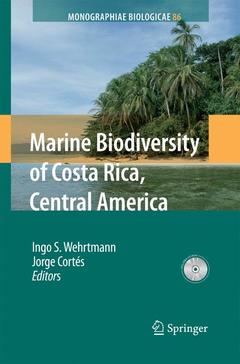Description
Marine Biodiversity of Costa Rica, Central America, 2009
Monographiae Biologicae Series, Vol. 86
Coordinators: Wehrtmann Ingo S., Cortés Jorge
Language: English
Keywords
Botany; Bryozoa; Chordata; Conservation; Costa Rica; Crustacea; Mangrove; Marine Biodiversity; Zoology; algae; biodiversity; environment; marine species; plankton; sponges
Marine Biodiversity of Costa Rica, Central America
Publication date: 11-2014
538 p. · 15.5x23.5 cm · Paperback
Publication date: 11-2014
538 p. · 15.5x23.5 cm · Paperback
Marine biodiversity of Costa Rica, Central America (Monographiae biologicae, Vol. 86)
Publication date: 12-2008
550 p. · Hardback
Publication date: 12-2008
550 p. · Hardback
Description
/li>Contents
/li>Biography
/li>Comment
/li>
Life began in the sea, and even today most of the deep diversity of the planet is marine. This is often forgotten, especially in tropical countries like Costa Rica, renowned for their rain forests and the multitude of life forms found therein. Thus this book focusing on marine diversity of Costa Rica is particularly welcome. How many marine species are there in Costa Rica? The authors report a total of 6,777 species, or 3. 5% of the world?s total. Yet the vast majority of marine species have yet to be formally described. Recent estimates of the numbers of species on coral reefs range from 1?9 million, so that the true number of marine species in Costa Rica is certainly far higher. In some groups the numbers are likely to be vastly higher because to date they have been so little studied. Only one species of nematode is reported, despite the fact that it has been said that nematodes are the most diverse of all marine groups. In better studied groups such as mollusks and crustaceans, reported numbers are in the thousands, but even in these groups many species remain to be described. Indeed the task of describing marine species is daunting ? if there really are about 9 million marine species and Costa Rica has 3. 5% of them, then the total number would be over 300,000. Clearly, so much remains to be done that new approaches are needed. Genetic methods have en- mous promise in this regard.
Diversity of Marine Habitats of the Caribbean and Pacific of Costa Rica.- A History of Marine Biodiversity Scientific Research in Costa Rica.- Marine Fossils.- Taxonomic Groups.- Phytoplankton.- Marine Benthic Algae.- Seagrasses.- Mangroves.- Foraminifera.- Sponges.- Hydrozoa, Scyphozoa, and Cubozoa (Medusozoa).- Siphonophores.- Zoanthids, Sea Anemones and Corallimorpharians.- Octocorals.- Stony Corals.- Sipunculans.- Polychaetes and Echiurans.- Stomatopods.- Euphausiids.- Decapod Crustaceans.- Shallow Water Mysids.- Cumaceans.- Tanaidaceans.- Isopods.- Gammaridean Amphipods.- Hyperiid Amphipods.- Barnacles.- Copepods.- Sea-Spiders.- Marine Insects.- Chitons.- Benthic, Shelled Gastropods.- Pelagic Gastropods.- Benthic Opisthobranchs.- Bivalves.- Squids and Octopuses.- Phoronids.- Bryozoans.- Brachiopods.- Echinoderms.- Chaetognaths or Arrow Worms.- Appendicularians (Urochordata).- Marine Fish.- Marine Reptiles and Amphibians.- Birds in Coastal and Marine Environments.- Marine Mammals.- Other Taxonomic Groups (Fungi, Kinorhynchs, Invertebrate Chordates).- Marine Fish Parasites.- Sea Turtle Parasites.- Marine Biodiversity of Costa Rica: Perspectives and Conclusions.
Ingo Wehrtmann:
- more than 50 published articles
- researcher and lecture at the Universidad de Costa Rica
- has worked in scientific institutions in Germany, Colombia, Chile, USA, Philippines and Costa Rica
- more than 20 years of experience in international scientific collaboration
- principal research area: decapod crustaceans in marine, estuarine and freshwater habitats
- Premio Nacional de Ciencias, Costa Rica, 1982
- more than 100 published papers
- editor of the book "Latin American Coral Reefs", 2003
- researcher and lecturer at Universidad de Costa Rica
- more than 25 years of experience in coral reef research
Jorge Cortés:
This book provides a compilation and update of species diversity in coastal and marine habitats of Costa Rica in particular and Central America in general. The compilation features species lists, comments on the state of knowledge of almost all taxonomical groups prepared by both national and international specialists. The book contains information about collections and experts for each taxonomic group as well as information gaps and serves as starting point and basic reference for future research. Includes supplementary material: sn.pub/extras
© 2024 LAVOISIER S.A.S.




